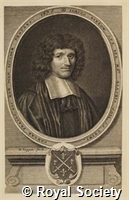| Authorised form of name | Barrow; Isaac (1630 - 1677); mathematician and theologian |
| Dates | 1630 - 1677 |
| Nationality | British |
| Place of birth | London, England, Europe |
| Date of birth | October 1630 |
| Place of death | London, England, Europe |
| Date of death | 4 May 1677 |
| DatesAndPlaces | Burial:
Westminster Abbey, London, England, Europe (7 May 1677) |
| Occupation | Clergyman, Church of England |
| Research field | Geometry |
| Optics |
| Activity | Education:
Charterhouse School; Felsted School; Peterhouse, Cambridge (1643); Trinity College, Cambridge (BA 1648/9, MA 1652, DD (1666)
Career:
Tutor to William Fairfax (3rd Viscount Fairfax of Emley); Fellow of Trinity (1649); incorporated at Oxford (1653); published compact editions of Euclid's 'Elements' (1656) and 'Data' (1657); travelled abroad (1655-1659); received Anglican ordination (1659); Fellow of Eton College (1660); Regius Professor of Greek at Cambridge (1660-1663); Professor of Geometry, Gresham College, London (1662-1663); Lucasian Professor of Mathematics at Cambridge (1663-1669); Prebendary of Salisbury (1671); Chaplain to Charles II; Master of Trinity College, Cambridge (1673-1677); Vice-Chancellor of Cambridge (1675-1676)
Honours:
Trinity College, Cambridge (BD honoris causa 1661)
|
| Membership category | Original Fellow |
| Date of election | 20/05/1663 |
| Age at election | 32 |
| Relationships | Parents: Thomas Barrow and Anne Buggin |
| PublishedWorks | RCN: 25283
RCN: 26651
RCN: 26652 |
| OtherInfo | Barrow's early education and subsequent career as a scholar were heavily shaped by the civil war years, with the Irish Rebellion of 1641 and the decline of trade there for his father resulting in a dependency on favours in securing Barrow a good education. Furthermore, Barrow was outspoken in his political and religious views and often needed to be defended against expulsion by his patron Thomas Hill. Barrow is credited with having a profound influence on his student Isaac Newton (FRS 1672) and thus having a so-called scientific genealogy relating him ultimately to Nobel prize winners. Barrow himself was not involved in the publication with his lectures on geometry, optics, and mathematics, and his father Thomas Barrow was instrumental in posthumous publication. |
| Related images | Discover a selection of related images in our picture library |
| Image | 
|
| Source | Sources:
Bulloch's Roll; DNB; DSB; Venn; ODNB
References:
R E W Maddison, 'Abraham Hill, FRS (1635-1722)' in NR 1960 vol 15 pp 173-182
A Rupert Hall, 'Cambridge: Newton's legacy' in NR 2001 vol 55 pp 205-226
Katherine Hill, 'Neither Ancient nor Modern: Wallis and Barrow on the Composition of Continua. Part One: Mathematical Styles and the Composition of Continua' in NR 1996 vol 50 pp 165-178, plate
Katherine Hill, 'Neither Ancient nor Modern: Wallis and Barrow on the Composition of Continua. Part Two: The Seventeenth-Century Context: The Struggle Between Ancient and Modern' in NR 1997 vol 51 pp 13-22
Milo Keynes, 'The Personality of Isaac Newton' in NR 1995 vol 49 pp 1-56, plate
Stuart Hollingdale, review of Mordechai Feingold, ed, Before Newton: the Life and Times of Isaac Barrow in NR 1991 vol 45 pp 277-279
G J Whitrow, 'Newton's Role in the History of Mathematics' in NR 1989 vol 43 pp 71-92
P Fara, 'Lucasian Professors. From Newton to Hawking: a history of Cambridge University's Lucasian professors of mathematics, ed K C Knox and R Noakes' in NR 2004 vol 58 pp 312-313
Notes:
The election date is Barrow's re-election date into the Society after the grant of the second charter in April 1663. All Fellows admitted in a two-month window after this charter, until 22 June 1663, are considered Original Fellows. He was previously elected on 17 September 1662 and admitted into the Society on 29 October 1662. |
| Code | NA7960 |
Archives associated with this Fellow
| RefNo | Title | Date |
| MS/20 | Manuscript of Isaac Barrow | [1630 - 1677] |
| CLP/24/21/1 | Letter, Discourse with mathematical rules from Mr [Isaac] Barrow to John Collins | 28 March 1668 |
| MS/19 | Further manuscripts of Isaac Barrow | [1630 - 1677] |
| CLP/24/21/2 | Diagram, by Isaac Barrow | 28 March 1668 |
| CLP/24/37/3 | Diagram, Isaac Barrow's solution to [Renatus Franciscus] Slusius' 'Construction of Solid Problems' [relayed by John Collins] | 17th century |
| CLP/24/21 | Letter, Discourse with mathematical rules from Mr [Isaac] Barrow to John Collins | 28 March 1668 |
| CLP/24/37/2 | Diagram, Isaac Barrow's solution to [Renatus Franciscus] Slusius' 'Construction of Solid Problems' [relayed by John Collins] | 17th century |
| MS/18 | Apollonii Conica methodo nova illustrata et succincte demonstrata per Isaacum Barrow | 1675 |
| CLP/24/37/1 | Paper, Isaac Barrow's solution to [Renatus Franciscus] Slusius' 'Construction of Solid Problems' [relayed by John Collins] | 17th century |
| CLP/24/25 | Paper, Isaac Barrow's paper concerning 'Gregory's Problem' as considered by John Collins | c.17th century |
| CLP/24/21/3 | Diagram, by Isaac Barrow | 28 March 1668 |
| CLP/24/10 | Paper, concerning the work of Isaac Barrow by John Collins | 17th century |
| CLP/24/33 | Letter, from John Collins to Henry Oldenburg [Secretary of the Royal Society] | 17th century |
| CLP/24/37 | Paper, Isaac Barrow's solution to [Renatus Franciscus] Slusius' 'Construction of Solid Problems' [relayed by John Collins] | 17th century |